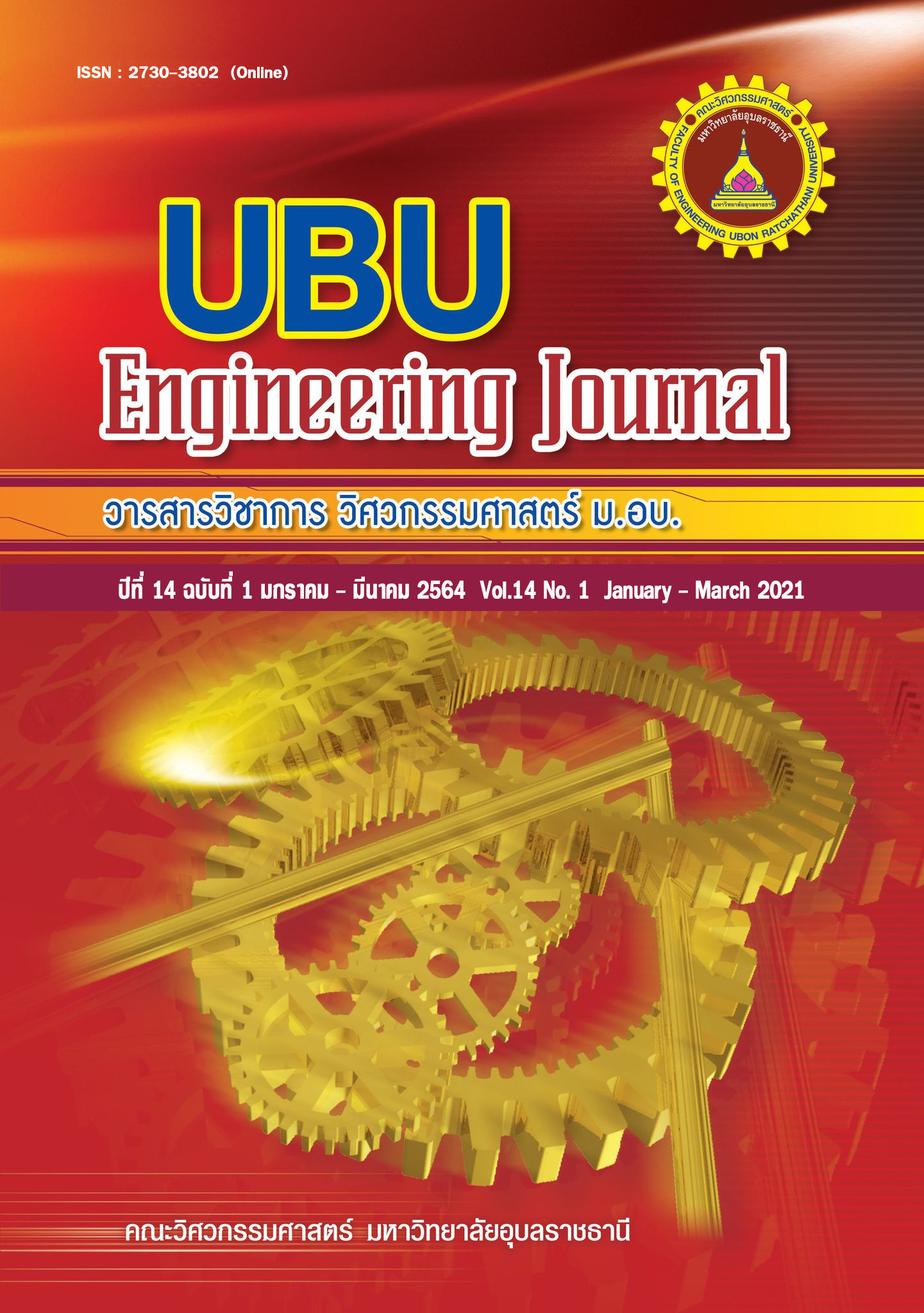Removal of Haloacetonitriles by UV-LED/Chlorine oxidation process
Main Article Content
Abstract
Haloacetonitriles (HANs) are in the group of nitrogenous disinfection byproducts (N-DBPs). HANs are more toxicity than regulated DBPs (trihalomethames and haloacetic acids). This work investigated the removal of monochloroacetonitrile (MCAN), dichloroacetonitrile (DCAN) and dibromoacetonitrile (DBAN) using UV-LED/Cl2 in comparison with UV-LED alone and Cl2 alone at pH 7 and 8. The results showed that the relationship between the decreasing of HAN concentration and time was the first order reaction. At pH 7, MCAN and DCAN removals under the UV-LED/Cl2 process had degradation rate constants (MCAN = 5.6 × 10-3 min-1, DCAN = 11.7 × 10-3 min-1) and removal efficiencies (27-52%) higher than UV-LED (MCAN = 4.4 × 10-3 min-1, DCAN = 5.1 × 10-3 min-1) and Cl2 (MCAN = 2.4 × 10-3 min-1, DCAN = 5.3 × 10-3 min-1). However, removal of DBAN under the UV-LED process was found to have a rate constant (6.4 × 10-3 min-1) and removal efficiency higher than UV-LED/Cl2 (5.6 × 10-3 min-1) and Cl2 (4.5 × 10-3 min-1). One-way ANOVA statistical results showed that HANs removal by UV-LED/Cl2 UV-LED and Cl2 processes were significantly different (p < 0.05). However, no statistically different for HANs removals among three processes at pH 8 (p > 0.05). The results of this work suggested that UV-LED/Cl2 can be an alternative method to remove HANs in drinking water.
Article Details
References
[2] Kiattisaksiri P, Khan E, Punyapalakul P, Ratpukdi T. Photodegradation of haloacetonitriles in water by vacuum ultraviolet irradiation: Mechanisms and intermediate formation. Water Research. 2016;98:160–7.
[3] Wagner ED, Plewa MJ. CHO cell cytotoxicity and genotoxicity analyses of disinfection by-products: An updated review. Journal of Environmental Sciences. 2017;58:64–76.
[4] World Health Organization. Guidelines for drinking-water quality: fourth edition incorporating the first addendum. 4th ed. 2017.
[5] Krasner SW, McGuire MJ, Jacangelo JG, Patania NL, Reagan KM, Aieta EM. The Occurrence of Disinfection By-products in US Drinking Water. Journal - American Water Works Association. 1989 Aug 1;81(8):41–53.
[6] Williams DT, LeBel GL, Benoit FM. Disinfection by-products in Canadian drinking water. Chemosphere. 1997 Jan 1;34(2):299–316.
[7] Goslan EH, Krasner SW, Bower M, Rocks SA, Holmes P, Levy LS, et al. A comparison of disinfection by-products found in chlorinated and chloraminated drinking waters in Scotland. Water Research. 2009 Oct 1;43(18):4698–706.
[8] Liew D, Linge KL, Joll CA. Formation of nitrogenous disinfection by-products in 10 chlorinated and chloraminated drinking water supply systems. Environmental Monitoring and Assessment. 2016;
[9] Bond T, Huang J, Templeton MR, Graham N. Occurrence and control of nitrogenous disinfection by-products in drinking water - A review. Water Research. 2011;45(15):
4341–54.
[10] Ratpukdi T, Sinorak S, Kiattisaksiri P, Punyapalakul P, Siripattanakul-Ratpukdi S. Occurrence of trihalomethanes and haloacetonitriles in water distribution networks of Khon Kaen Municipality, Thailand. Water Science and Technology: Water Supply. 2019;19(6):1748–57.
[11] Fang J, Fu Y, Shang C. The roles of reactive species in micropollutant degradation in the UV/free chlorine system. Environmental Science and Technology. 2014 Feb 4;48(3):1859–68.
[12] Wang D. Application of the UV/Chlorine advanced oxidation process for drinking water treatment. University of Toronto; 2015.
[13] Khan SJ, Gagnon GA, Templeton MR, Dionysiou DD. The rapidly growing role of UV-AOPs in the production of safe drinking water. Environmental Science: Water Research and Technology. 2018;4(9):1211–2.
[14] Chen J, Loeb S, Kim J-H. LED revolution: fundamentals and prospects for UV disinfection applications. Environmental Science: Water Research and Technology. 2017;3(2):188–202.
[15] Davis ML. Water and Wastwater Engineering Design Principles and Practice. USA: McGraw-Hill; 2010.
[16] Yin R, Zhong Z, Ling L, Shang C. The fate of dichloroacetonitrile in UV/Cl2 and UV/H2O2 processes: Implications on potable water reuse. Environmental Science: Water Research and Technology. 2018;4(9):1295–302.
[17] Kwon M, Yoon Y, Kim S, Jung Y, Hwang T-M, Kang J-W. Removal of sulfamethoxazole, ibuprofen and nitrobenzene by UV and UV/chlorine processes: A comparative evaluation of 275 nm LED-UV and 254 nm LP-UV. Science of The Total Environment. 2018 Oct;637–638:1351–7.
[18] Wang WL, Wu QY, Li ZM, Lu Y, Du Y, Wang T, et al. Light-emitting diodes as an emerging UV source for UV/chlorine oxidation: Carbamazepine degradation and toxicity changes. Chemical Engineering Journal. 2017;310:148–56.
[19] Prarat P, Ngamcharussrivichai C, Khaodhiar S, Punyapalakul P. Adsorption characteristics of haloacetonitriles on functionalized silica-based porous materials in aqueous solution. Journal of Hazardous Materials. 2011;192(3):1210–8.
[20] U.S.EPA. Method 551.1: Determination of chlorination disinfection byproducts, chlorinated solvents , and halogenated pesticides/ herbicides in drinking water by liquid-liquid extraction and gas chromatography with electron-capture detection. 1st ed. Ohio: United States Environmental Protection Agency; 1995. P. 1–61.
[21] Kiattisaksiri P. Removal of haloacetonitriles (HANs) and dissolved organic nitrogen (DON) in water by vacuum ultraviolet (VUV). Chulalongkorn University; 2016.
[22] David M. Levine, Patricia P. Ramsey RKS. 10.4 THE ONE-WAY ANALYSIS OF VARIANCE (ANOVA). In: Applied Statistics for Engineers and Scientists: Using Microsoft Excel and Minitab. 1st ed. New Jersey: Prentice-Hall, Inc.; 2001. p. 472–84.
[23] Shi W, Wang L, Chen B. Kinetics, mechanisms, and influencing factors on the treatment of haloacetonitriles (HANs) in water by two household heating devices. Chemosphere. 2017. 17: 278-285.
[24] Deborde M, von Gunten U. Reactions of chlorine with inorganic and organic compounds during water treatment-Kinetics and mechanisms: A critical review. 42, Water Research. 2008. p. 13–51.
[25] Miklos DB, Remy C, Jekel M, Linden KG, Drewes JE, Hübner U. Evaluation of advanced oxidation processes for water and wastewater treatment – A critical review. Water Research. 2018 Aug 1;139:118–31.

